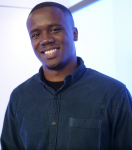Have you ever wondered what it takes to break the mold, transcend boundaries and reach for the stars? Ozan Varol, a rocket scientist turned professor and bestselling author, knows a bit about that.
Varol stopped by SAS Explore in Las Vegas and used his creativity and critical thinking expertise to give strategies for challenging the status quo. From his journey from Istanbul, where he grew up, to the Mars Rover Mission, his speech exemplified the spirit of curiosity and innovation.
In his book Think Like a Rocket Scientist, Varol focused on the idea of "moonshot models," which boils down to the intersection between idealism and pragmatism. They essentially sum up long-term goals and unique ways of reaching those goals. Of the moonshot model, Varol focused his speech on two main areas: reimagination and acceleration.

Reimagination unlocks competitive advantage
Frequently, people tend to adopt certain procedures simply because they’ve been in place for a long time. Varol noted that these patterns can be tempting because they offer a sense of familiarity and ease. However, he also noted the harm in failing to reimagine these processes. This mindset can work in the short term but ultimately leads to a recipe for long-term disaster. Embracing a mindset of reimaging what’s possible creates opportunities to speed past competitors with new and exciting ways of thinking and innovating. Varol stressed the importance of understanding backcasting and abandoning outdated tactics within reimagination.
- Backcasting: When contemplating the future, we often forecast by projecting our current state onto where we aspire to be. This usually begins with following the status quo and projects biases and assumptions about what can be accomplished in the future. Backcasting flips the script by wiping the slate clean, beginning with an idea for the future and working backward to make it a reality.
- Abandoning outdated tactics: Varol emphasized the difference between strategy (the overarching plan) and tactics (the tools and actions used to implement a plan). He urged listeners to shift focus away from the triviality of tactics and ask themselves, “Why am I doing it?” This mindset helps us spot the tactics that are getting in our way and helps us reimagine possibilities we otherwise wouldn’t have seen.
Acceleration sparks creative excellence
In an age of constant noise, “letting your mind drift” is important, Varol says. Varol described the “pedal to the metal” mentality as the enemy of thought. Sometimes, taking your foot off the pedal might be the best way to accelerate. Other nuggets Varol told the crowd were that “creativity is discovered, not produced” and “it [creativity]happens in moments of relaxation, not hard labor.” It’s essential to devote time to thinking because the best ideas and solutions “often do not come at the drop of a hat,” he said. Varol shared two important ideas within acceleration: focusing less on “what is” and more on “what can be” and the idea of uncertainty.
- Less of “what is” and more of “what can be”: Excessive focus on the present state can lead to repetitive thinking. To innovate, Varol suggested taking time to think between meetings, going for a walk without music or podcasts and even blocking time on calendars just to think.
- The idea of uncertainty: Commonly, progress and breakthroughs are often made in times of uncertainty. Varol shared, “If you stick to the familiar, you’ll never find the unexpected.”
“The path forward isn’t going to present itself with perfect clarity until after you start to walk,” said Varol. “As you take each step, you go from not knowing to knowing. The best way to know what comes next is to start walking before you think you’re ready.”

